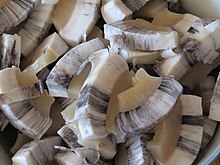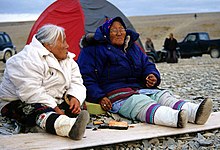Muktuk

Muktuk
Methods of preparation


In Greenland, muktuk (mattak) is sold commercially to fish factories,[4] and in Canada (muktaaq) to other communities.[5]
When chewed raw, the blubber becomes oily, with a nutty taste; if not diced, or at least serrated, the skin is quite rubbery.[citation needed]
One account of a 21st century
Nutrients and health concerns
Muktuk has been found to be a good source of
Proceedings of the Nutrition Society stated in the 1950s that:
The most important item of food of the Polar
Eskimos is the narwhal (Monodon monoceros). [...] The skin (mattak) is greatly relished and tastes like hazel-nuts; it is eaten raw and contains considerable amounts of glycogen and ascorbic acid. The White whale (Delphinupterus leucas) is almost as important...[16]
Contaminants from the industrialised world have made their way to the Arctic marine food web. This poses a health risk to people who eat "country food" (traditional Inuit foodstuffs).[17] As whales grow, mercury accumulates in the liver, kidney, muscle, and blubber, and cadmium settles in the blubber,[18] the same process that makes mercury in fish a health issue for humans. Whale meat also bioaccumulates carcinogens such as PCBs, chemical compounds that damage human nervous, immune and reproductive systems,[19][20] and a variety of other contaminants.[21]
Consumption of muktuk has also been associated with outbreaks of botulism.[22]
Spellings
Transliterations of "muktuk", and other terms for the skin and blubber, include:
- Ikiilgin, Chukchi
- Maktaaq (ᒪᒃᑖᖅ), North Baffin, East Baffin, South Baffin[23]
- Maktak (ᒪᒃᑕᒃ),
- Maktaq, Inuinnaqtun,[26] Natsilingmiutut (Inuvialuktun)[27]
- Mattak, Labrador, Greenland[28]
- Mangtak, Alaskan Yup'ik[29]
- Mungtuk, Siberian Yupik
- Kimaq, Alutiiq/Sugpiaq
In some dialects, such as Inuinnaqtun, the word muktuk refers only to the edible parts of the whale's skin and not to the blubber.[26][30]
See also
- Nalukataq, spring whaling festival
- Marine mammals as food
- Chukchi cuisine
References
- ^ "muktuk". Asuilaak Living Dictionary.
- ISBN 978-0-8108-6822-9.
- ^ "10 Weirdest Foods in the World". News.travel.aol.com. 9 September 2010. Archived from the original on 11 September 2010. Retrieved 11 September 2013.
- .
- ^ Hoover C, Bailey M, Higdon J, Ferguson SH, Sumalia R (March 2013). "Estimating the Economic Value of Narwhal and Beluga Hunts in Hudson Bay, Nunavut". The Arctic Institute of North America. 66: 1–16.
- OCLC 183162209.
- OCLC 183162209.
- ^ Magazine, Tusaayaksat (15 April 2015). Tusaayaksat – Spring 2015. Tusaayaksat Magazine.
- ^ Goward, Sydney (10 August 2021). "Exploring Tuktoyaktuk: Pingos, Muktuk, and the Arctic Ocean". My Site. Retrieved 6 April 2022.
- ISBN 9780748132775.
- OCLC 1265523671.)
{{cite book}}: CS1 maint: location missing publisher (link) CS1 maint: others (link - JSTOR 40508955.
- .
- ISBN 978-1-139-23652-2
- .
- S2CID 71578987.
- ^ "Country Food (Inuit Food) in Canada | The Canadian Encyclopedia". www.thecanadianencyclopedia.ca. Retrieved 6 April 2022.
- doi:10.1139/f83-326.
- ^ "Chemical Compounds Found In Whale Blubber Are From Natural Sources, Not Industrial Contamination". 18 February 2005.
- ^ "Japan warned on 'contaminated' blubber". BBC News. 24 January 2001. Retrieved 31 December 2009.
- ^ "Google Scholar". scholar.google.com. Retrieved 18 November 2018.
- S2CID 20417910.
- ^ "maktaaq". Asuilaak Living Dictionary.
- ISBN 1-881246-01-9
- ^ "maktak". Asuilaak Living Dictionary.
- ^ a b Ohokak, G.; M. Kadlun; B. Harnum. Inuinnaqtun-English Dictionary (PDF). Kitikmeot Heritage Society. Retrieved 3 April 2016.
- ^ "maktaq". Asuilaak Living Dictionary.
- ^ "mattak". Asuilaak Living Dictionary.
- ^ Jacobson, Steven A. (2012). Yup'ik Eskimo Dictionary, 2nd edition Archived 3 August 2017 at the Wayback Machine. Alaska Native Language Center.
- ^ "edible whale skin". Asuilaak Living Dictionary.
External links
 Media related to Maktaq at Wikimedia Commons
Media related to Maktaq at Wikimedia Commons
